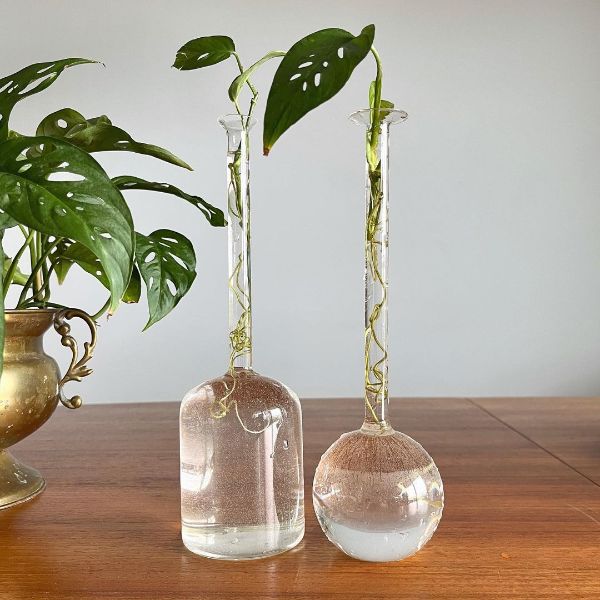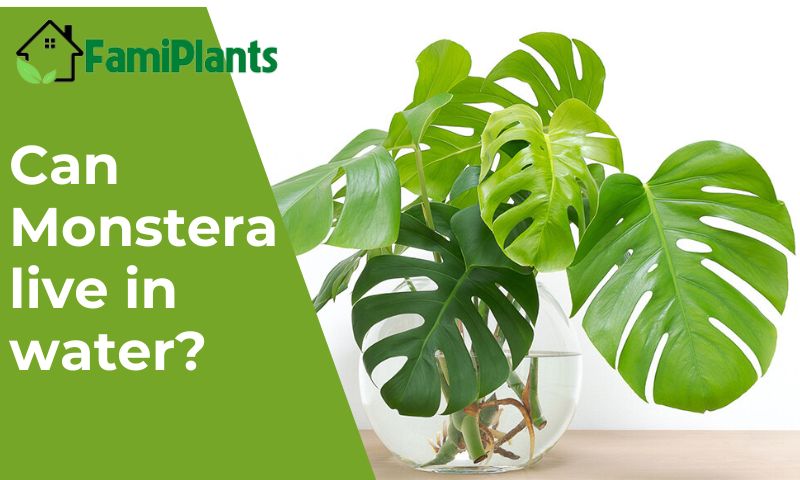If you’re a fan of plants and thinking about adding a Monstera to your collection, you might be scratching your head wondering if this popular plant can really grow in water. Well, the question “Can Monstera live in water?” isn’t a straightforward yes or no – it depends on a bunch of things. In this piece, we’ll cover all you need to know about growing Monstera plants in water, like the good and bad points, the best conditions, and how to make more Monstera plants using water. Keep reading to find out more about this cool plant and how to look after it in water, whether you’re an old hand at plants or just starting out.
Can Monstera live in water?
Yes, Monstera plants can live for a little while in water, but since they still need soil or other stuff to keep going in the long run, they’re not real hydroponic plants. Monstera can grow in water, but doing it for too long might make the roots rot and other stuff go wrong. If you decide to grow Monstera plants in water, don’t forget they like soil that drains well, so you gotta be extra careful to make sure the roots don’t sit in stale water for too long. If you want to give growing your Monstera in water a shot, remember to change the water now and then and give it some food.

The Benefits of Growing Monstera in Water
Monstera plants usually grow in soil, but putting them in water has some cool bonuses. Here’s what I mean:
- Making more plants (Propagation): Monstera plants are easy to grow in water if you want to make more of them. It’s a great choice if you want more plants without having to buy them.
- Looks cool (Aesthetic appeal): You can see the Monstera plant’s roots growing in the water, and it makes for a really cool visual.
- Not much work (Low maintenance): Since you don’t need soil and all the stuff that goes with it like watering and fertilizing, growing Monstera plants in water can be a laid-back option.
- Fewer bugs (Reduced pest issues): Putting Monstera plants in water can cut down on the annoying problems with fungus and bugs that come with soil.
Now, growing Monstera plants in water has its plus points, but you gotta be careful not to let the roots hang out in stale water too long. That can cause the roots to rot and lead to other problems.
Cons of growing a Monstera in water
- Growing a Monstera in water needs regular and careful upkeep. You’ve got to keep an eye on the water levels, switch it out with fresh tap or filtered water every few weeks, and make sure no junk or bugs mess with the plant.
- Since putting Monsteras in water is kinda new, there’s a chance your plant could catch a disease or bugs because it’s not used to growing that way. No soil means the plant won’t get the nutrients it usually does, so you might need to add some liquid fertilizers.
- If you’re new to plants, growing a Monstera in water might be tough. It takes a lot of time and knowing just the right way to do things. If you’re not up for regular care or don’t have the know-how, it might be tricky.
- Growing in water doesn’t give the Monstera enough support since its roots can’t dig into soil and hold up the growing parts. So growing a Monstera in water might not be the best idea for big plants or ones with long vines.
- Putting Monsteras in water can get pricey. You might need to buy extra stuff like special fertilizers and growing gear. Keep that in mind if money’s tight.
- You’ve got to watch out for root rot, which can happen if the plant’s roots sit in water too long. It can cause things like yellow leaves and slow growth.
How to Grow Monstera in Water?
So, you wanna know how to grow Monstera in water now that you know the good and bad sides? Here’s what you do:

Step 1: Choose a Container
Find a glass or ceramic container. I like the see-through or sorta see-through ones so you can check out the roots.
You also need to find something that’ll let your plant stand up straight. Skinny-necked bottles, container, and vases are cool. Pick one with a wide enough neck; you’ve gotta be able to get the plant out of there to mess with the roots.
Step 2: Put the Monstera in the Container
If you intend to propagate an existing Monstera, snip off a piece and put it in the container.
You could also take a potted plant and make it live in water, but that’s gonna be a mess.
Take your plant out of its pot real careful and shake off as much soil as you can. Give the roots a good rinse in warm water to get rid of any leftover soil. To get the soil really loose, let the roots hang out in a bucket of water for a bit.
Don’t sweat it if you can’t get all the soil off. Your plant’s roots will change when you switch it from soil to water. As new water roots show up, your plant will ditch the old soily ones.
I like to make more Monstera from one I already have. I don’t have the patience to get all the soil off a potted plant.
Step 3: Pour in the water container
Fill the container about halfway with water so it covers the roots. Pluck off any leaves that are too far down the stem. You don’t want any leaves under the water. Give it a couple of weeks, and you’ll see some roots popping out.
How to maintain water oxygenation?
When you’re growing Monstera plants in water, you gotta make sure there’s enough oxygen going on in there. It helps stop the roots from rotting and makes the plant grow strong. Here’s how you can keep that water nice and oxygen-rich:
- Use a bubble-maker (air stone): Get yourself an air stone to put some tiny bubbles in the water. It’s this little thing with holes in it that hooks up to an air pump. It’s gonna help keep the roots happy and get more oxygen in the water.
- Switch the water out now and then: You don’t want the water getting all stale and losing its oxygen. So make sure to change the water in your Monstera’s jar or whatever. Try to do it every week or two.
- Get a water pump: You can also use a water pump to make the water move around more and get more oxygen in there. Just make sure to pick a pump that’s the right size for your container.
- Throw in some hydrogen peroxide: You can put a little bit of hydrogen peroxide in the water. It’ll help bump up the oxygen and stop any nasty bacteria from growing.
If you stick to these tips, you’ll help make sure your Monstera plant grows nice and strong in the water, with plenty of oxygen to keep it healthy.
Tips on how to grow a Monstera in water
Want to grow a Monstera in water? Here’s how you can do it:
- Cut and Stick: Growing a Monstera in water? Easy! Just snip a stem from a healthy plant right below a node, pluck off the bottom leaves, and pop it in a jar filled with water. Change the water now and then, and keep it somewhere with lots of bright, indirect light.
- Pick a Cool Jar: Go for a clear glass or plastic jar or something. That way, you can keep an eye on the roots and make sure they aren’t chilling in stale water.
- Water Stuff: Use filtered or bottled water instead of tap water. Tap water has all kinds of minerals and stuff that might not be great for your plant.
- Feed It: Monsteras need food too. Mix in some liquid fertilizer with the water every couple of weeks to give your plant what it needs.
- Find the Right Spot: Monsteras are pretty chill with low light, but they really like bright, indirect light. Put your jar somewhere it can catch a few hours of that kind of light every day.
- Check the Roots: Keep an eye on the roots to make sure they’re looking good and not getting all rotten or sick. If something looks off, switch out the water right away and change up your care routine if you need to.
Follow these tips, and you’ll have yourself a Monstera growing in water in no time. Plus, it’s a cool look and easy to take care of.
Growing Monstera in water is a neat way to bring a little bit of nature into your place. Monsteras can hang out in water, but you’ve got to take care of them right. That means keeping things moist but not too wet, and feeding them regularly. Got questions? Head over to Famiplants. We’ve got all kinds of info on Monsteras, including what to do and what not to do.

